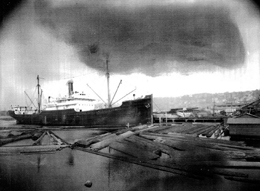On June 3, 1918, the New York-based engineering firm Sanderson & Porter launches the steamship Fonduco from its shipyard in Raymond. It’s the first of five wooden steamships the shipyard will build for a federal agency set up to fill the urgent demand for thousands of ships to serve the U.S. military effort in World War I.
A Need for Ships
Not long after the United States entered World War I in April 1917, the federal government formed the Emergency Fleet Corporation to build new wooden and steel ships to ferry soldiers and supplies to battlegrounds in Europe. The new agency had a budget of $3.6 billion and needed shipyards. According to Charles M. Schwab (1862-1939), Director General of the Emergency Fleet Corporation, the American shipbuilding industry had languished after the Civil War, and the country lacked sufficient shipyards and experienced shipwrights to carry out the construction of the thousands of ships that were needed. Moreover, steel shipbuilders that the Emergency Fleet Corporation approached to build the ships were already operating at full capacity, so the agency looked to wooden shipbuilders to make up the difference.
Sanderson & Porter was among the shipbuilding companies to win contracts for the fleet's ships. The firm sent representatives to the Pacific Northwest to locate shipyards, and they found Raymond, with its location on the Willapa River and proximity to thousands of acres of forestland and the Pacific Ocean, nearly ideal.
Building the Site to Build the Ships
On April 29, H. Hobart Porter (1865-1947) or his brother Seton (1882-1953) presented plans to residents of Raymond for a 20-acre shipyard on the north fork of the Willapa River, about a quarter-mile upriver from where the Highway 101 bridge crosses the river. Sanderson & Porter planned to build 10 cargo ships at the Raymond shipyard, which would employ at least 1,000 workers. It would also bring work to the area's mills and Raymond's other businesses. The city gladly built streets and laid water mains to prepare the site. The Chicago, Milwaukee & St. Paul railroad ran a spur line to the building site from its main line, and Willapa Electric installed lights on the river bank to make a night shift possible.
As soon as the firm had secured a lease to the site, in June, Sanderson & Porter began construction on the shipyard. After driving 5,000 piles, workers used 5 million board feet of lumber to build a 400,000-square-foot working platform and 20 buildings for offices, machinery, and other uses.
Factory Methods Build Fonduco Fast
The shipyard built Ferris-type ships, named for Theodore E. Ferris (1872-1953), the naval architect who designed them. Given the government’s urgent need for about 3,000 ships to win the war, the Emergency Fleet Corporation hired Ferris to design a ship that could be assembled efficiently and quickly at multiple shipyards. According to George Weiss in America's Maritime Progress, Ferris at first declined the job, because he considered it "impossible to apply factory methods to the art of shipbuilding." But he eventually signed on and successfully designed the Ferris-type ships that dozens of shipyards around the country produced for the war effort (Weiss, 153).
On November 2, 1917, workers laid the first keel. The following June 3, they launched the Fonduco, a 281-foot cargo ship. It contained 1.8 million board feet of lumber, 400 bales of oakum (a caulking material used to seal the spaces between wooden planks), 10,000 pounds of clinch rings for attaching the ship’s planking to its ribs, 20,000 trunnels (wooden pegs), 600 gallons of paint and oil, 200 tons of round iron used to make rivets, 4,000 pounds of white and red lead as preservatives, and 30 tons of iron strapping.
Breaking Records
Over the next year, four more Ferris-type cargo ships would launch from the Raymond shipyard. A competition ensued among the shipyards building Ferris ships. In August, the Raymond yard captured the record by framing a ship in 37 hours and 15 minutes. The next month, Raymond workers again broke the record by reducing their time to 29 hours and 40 minutes. The Grant Smith-Porter yard in Aberdeen broke the record one last time in late September. Measured in person-hours, the Aberdeen yard had framed a ship in 1,452 hours, compared with Raymond's best time of 2,309 hours.
At this rate, the Kenosha, Pezuta, Addison, and Anthon rolled off the ways and into the water at a rapid pace. The yard did not reach its original goal of building one ship every 15 days, but the armistice ended the war that November, cutting production short. After employing 1,300 workers for two years, the shipyard closed in 1919, bringing an end to wooden cargo ship construction at Raymond.
Smaller boat builders have continued to build and repair boats on the Willapa River. The Louderback family, which started their boat-building shop in the 1880s where East Raymond is now (2011), continued to produce tugboats and fishing boats until recently. The Fosse family's South Bend Boat Shop, started in 1926, built wooden fishing and oyster boats and is now run by Chris, the third generation of Fosses to operate the business. Pedigree Cats Catamarans has built custom boats in Raymond since 1995.

